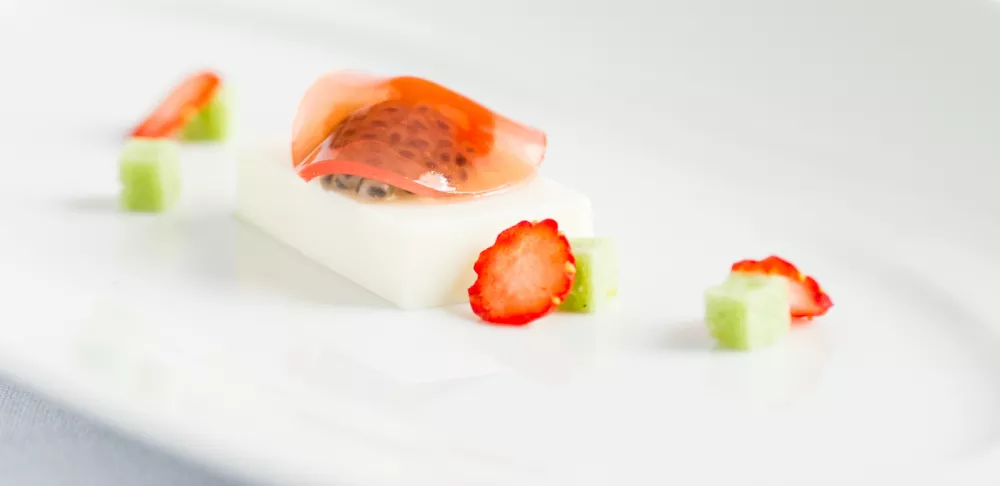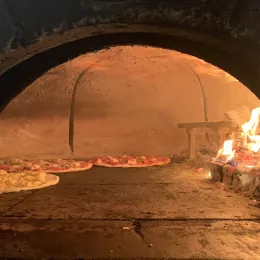I've helped over 300 students select their externship in the time that I've been at ICE. So, when it came time for me to decide, I thought I had it pretty much covered. I decided to challenge myself in a restaurant where I imagined I would learn speed and be in a place that feels familiar to me given my past front-of-house experience.
My decision was a Spanish restaurant on the Upper West Side named Graffit. Aside from loving all things Spanish, I had known Chef Jesus Nunez for some time and was really attracted to his philosophy of combining food and art as well as building a family-like team. So, I informed my advisor of the details, an agreement for my 210-hour externship was put in place, and I was ready to embark on my first professional back-of-house experience.
All I really remember from my first day at Graffit is that I felt hot. As I made my way up to the kitchen in my checkered pants, an unmarked chef coat and my big black kitchen shoes, I was introduced to my new pastry mentor, Rachel, and instantly felt myself start to sweat. I had a sudden flashback of walking into the kitchen at Extra Virgin, seeing the line cooks with beads of sweat rolling down their faces as they worked through our Friday night rush.
At that time, I thought I had a pretty good understanding of what it was like to work in a kitchen. Even in my role at ICE, I have visited numerous kitchens and learned about the lifestyle of a cook by reading books like Kitchen Confidential and having countless conversations with chefs. I knew from these experiences, that life in the kitchen was hard and meant long hours.
I had stood for hours greeting and seating guests while working front-of-house, but working in a kitchen is just so much more physical than I ever expected — up and down the stairs to the prep area, back and forth to the walk-in, moving in the rhythm of a kitchen that during service is nothing short of organized chaos. Within a week, I learned my first lesson: front-of- house is not back-of-house.
It was no surprise that Jesus, both a chef and a Spaniard, believes passion is the key ingredient in preparing and presenting his food. Once I finally learned the 10 to 20 components of each dessert and observed Rachel plating each, it was my turn to jump in. I have to admit, it was hard.
Graffit is unusual in that Chef Jesus believes so much in the passion on the plate that he expects each dish to look a little different each time — it’s own individual piece of art. The components will all always be there, but the presentation is in the hands of each plate-er. This would be a dream come true for many externs, some of which never get the opportunity to leave the prep kitchen, never mind create the look of the dish going out to the dining room.
But for me, this was torture. I like consistency. I like to know where to put what and how much of it to put there. But when I would ask, there was no true answer. It sounds corny, but the answer was within. Chef Jesus would walk by while I was plating chocolate fritter dessert, which ends up looking more like an abstract painting than a dessert, and question, “Where is your passion? I don’t see any passion there.”
That was when I decided I had to learn how to let go. With each dessert, I let go a little more and three weeks later, I’m proud to report I’m not hearing, “Where’s your passion?” as often as I used to.
Once a week, I come in for a full day and get the opportunity to do what I expected most to do as an extern — prep work. I imagined it would be repetitious, lackluster, and annoying at times, and it is. But what I didn’t realize is how much I would appreciate it and how doing both production and service has made the whole experience come full circle.
Since I’ve plated “Spring is Coming,” I know how thinly the fennel needs to be cut so it looks right on the dish. I know how much texture I need to add to the orange purées that will be splashed onto the chocolate fritter dish. I know how small the sangria gel, apples and pears need to be diced for the deconstructed sangria. Through the repetition of preparing all this mise en place, something happens — confidence is built. I feel myself thinking of ways that I can be faster or more efficient when I’m doing something.
When I revert back to a slow mode, Rachel will ask, “Why are you going so slow? We have to get this out to the table.” It's an immediate reminder of why we’re even doing all of this — the guests. I can’t see their faces, but I’m serving them in probably the deepest way possible — with passion. Next up: the second half of my externship! Graduation is officially a month away.




